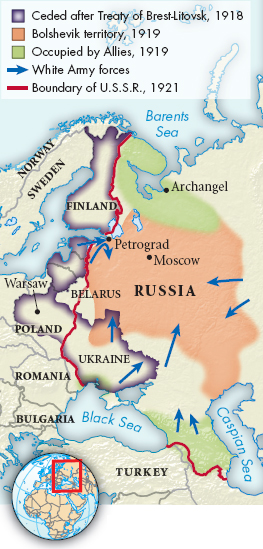Dictatorship and Civil War
The Bolsheviks’ truly monumental accomplishment was not taking power, but keeping it. Over the next four years, they conquered the chaos they had helped create and began to build a Communist society.
The Bolsheviks promised that a freely elected Constituent Assembly would draw up a new constitution. But free elections in November produced a stunning setback: the Bolsheviks won only 23 percent of the elected delegates. The Socialist Revolutionary Party — the peasants’ party — had a clear plurality with about 40 percent of the vote. After the Constituent Assembly met for one day, however, Bolshevik soldiers acting under Lenin’s orders disbanded it. By January 1918, Lenin had moved to establish a one-
Lenin acknowledged that Russia had effectively lost the war with Germany and that the only realistic goal was peace at any price. That price was very high. Germany demanded that the Soviet government give up all its western territories.
At first, Lenin’s fellow Bolsheviks refused to accept such great territorial losses. But when German armies resumed their unopposed march into Russia in February 1918, Lenin had his way. A third of old Russia’s population was sliced away by the Treaty of Brest-Litovsk, signed with Germany in March 1918. With peace, Lenin escaped the disaster of continued war and could pursue his goal of absolute power within Russia.
The peace treaty and the abolition of the Constituent Assembly inspired armed opposition to the Bolshevik regime. The officers of the old army organized the so-
By the summer of 1918, Russia was in a full-
Lenin and the Red Army beat back the counter-

Ironically, foreign military intervention helped the Bolsheviks. For a variety of reasons, but primarily to stop the spread of communism, the Western Allies sent troops to support the White armies. Yet their efforts were limited and halfhearted. By 1919, with the Great War over, Westerners were sick of war, and few politicians wanted to get involved in a new military crusade. Allied intervention failed to offer effective aid, though it did permit the Bolsheviks to appeal to the patriotic nationalism of ethnic Russians.
Other conditions favored a Bolshevik victory as well. Strategically, the Reds controlled central Russia and the crucial cities of Moscow and Petrograd. The Whites attacked from the fringes and lacked coordination. Moreover, the poorly defined political program of the Whites was incapable of uniting the Bolsheviks’ enemies. And while the Bolsheviks promised ethnic minorities in Russian-
The Bolsheviks mobilized the home front for the war by establishing a system of centralized controls called War Communism. The leadership nationalized banks and industries and outlawed private enterprise. Bolshevik commissars introduced rationing, seized grain from peasants to feed the cities, and maintained strict workplace discipline.
Revolutionary terror also contributed to the Communist victory. Lenin and the Bolsheviks set up a fearsome secret police known as the Cheka. During the civil war, the Cheka imprisoned and executed without trial tens of thousands of supposed “class enemies.” The tsar and his family were executed in July 1918. The “Red Terror” of 1918 to 1920 helped establish the secret police as a central tool of the new Communist government.
By the spring of 1920, the White armies were almost completely defeated, and the Bolsheviks had retaken much of the territory ceded to Germany under the Treaty of Brest-
>QUICK REVIEW
How were the Bolsheviks able to gain and hold power in Russia?